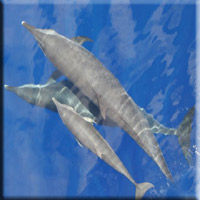|
Atlantic spotted dolphins (Stenella frontalis) apparently teach their calves foraging skills, researchers say. A video (MPEG format) shows activity that scientists believe may represent teaching behavior. (Image courtesy NOAA)
|
With fluid, sometimes playful-looking movements, a mother dolphin leads her calf to the seafloor and starts poking around for a meal—fish hiding in the sand. The youngster seems to watch closely.
The scene, captured on video, is one of many cases filmed by researchers of what they describe as dolphins apparently teaching their young.
While a few animal species have been reported to “teach” their young survival skills, dolphins seem to display some teaching innovations shown by none others except humans, scientists say in a new study.
Researchers are fascinated by reports of animal teaching because it may reveal an ability thought to be possibly unique to humans—the capacity to infer someone else’s thoughts. This ability, a milestone in evolution, is sometimes called “theory of mind.”
Another creature described as having impressive teaching strategies is the meerkat, a type of mongoose. One study noted that meerkats give their young injured prey, such as stinger-deprived scorpions, so the pup can finish the kill and enjoy the meal. The adult looks on, providing more aid if necessary. As pups grow, adults gradually hike the difficulty level by offering harder-to-handle prey.
Dolphin “teaching” appears to involve some different tricks, according to the new study. These include an apparent communication component: the ocean mammals make “pointing” motions with their snout, actions previously documented in captivity but not in the wild.
The findings add to previous research suggesting dolphins have a “theory of mind,” according to the investigators, but they added that more evidence may be needed.
Regardless, the study shows teaching may be a key to how dolphin “social learning and possibly culture are transmitted from one generation to the next,” wrote the researchers, Courtney Bender of Florida Atlantic University and colleagues, in the study. The report appears in the July 29 online issue of the research journal Animal Cognition.
Bender and collaborators analyzed archives of videos taken of Atlantic spotted dolphins between 1991 and 2004 from the archives the Wild Dolphin Project, a research group based in Jupiter, Fla. They compared the foraging activities of mothers when they were in and out of the presence of their own calves. The idea was that mothers might change their foraging styles in particular ways to make a “teaching” experience of it.
Analyzing 38 episodes of foraging, each lasting from an initial search to a capture and eating of prey, the team reported significant differences in the episodes with calf present. The most striking change: when the calf was there, mothers stretched out the chase eight times longer on average, repeatedly capturing, letting go and re-capturing the same victim—as if to demonstrate the technique.
“These exaggerated foraging behaviors may provide a window of opportunity for the calves to observe, and possibly learn from, the example,” Bender and colleagues wrote.
But the pointing-like gestures seen during the foraging with calves were “particularly interesting,” they added. These consisted of “exaggerated movements in the direction of the prey,” orienting the body in its direction, as if to point it out. This “may be an attention-directed referential behavior similar to the spontaneous pointing observed by dolphins during experiments in captivity,” Bender’s group wrote.
To confirm whether the observed behavior is really teaching, researchers are currently analyzing whether the calfs are really learning from it, the scientists added. But even without that data, they wrote, “we believe that this study detailing the altered foraging behavior of the mothers is a significant finding in the area of animal cognition.”

